高中英语语法过去分词_done
- 格式:ppt
- 大小:184.50 KB
- 文档页数:12
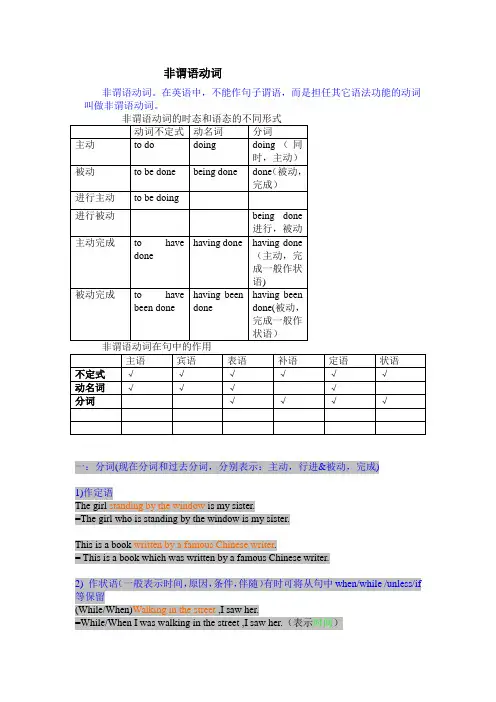
非谓语动词非谓语动词。
在英语中,不能作句子谓语,而是担任其它语法功能的动词叫做非谓语动词。
非谓语动词的时态和语态的不同形式动词不定式动名词分词主动to do doing doing(同时,主动)被动to be done being done done(被动,完成)进行主动to be doing进行被动being done进行,被动主动完成to havedone having done having done(主动,完成一般作状语)被动完成to havebeen done having beendonehaving beendone(被动,完成一般作状语)非谓语动词在句中的作用主语宾语表语补语定语状语不定式√√√√√√动名词√√√√分词√√√√一:分词(现在分词和过去分词,分别表示:主动,行进&被动,完成)1)作定语The girl standing by the window is my sister.=The girl who is standing by the window is my sister.This is a book written by a famous Chinese writer.= This is a book which was written by a famous Chinese writer.2) 作状语(一般表示时间,原因,条件,伴随)有时可将从句中when/while /unless/if 等保留(While/When)Walking in the street ,I saw her.=While/When I was walking in the street ,I saw her.(表示时间)Seen from the hill,our school looks more beautiful.=When our school is seen from the hill,it looks more beautiful.从小山上看,我们学校更美了。
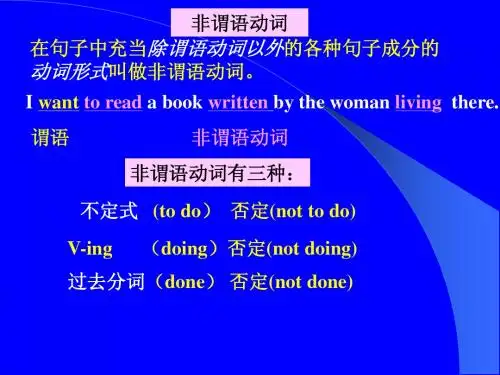

高中英语不规则动词表动词原形中文意思过去式过去分词arise出现arose arisen awake醒来awoke awaked / awoken baby-sit*临时照顾baby-sat baby-sat be(am/is/are)是was / were beenbeat击打beat beaten become变成became become begin开始began begun bend使弯曲bent bent bet赌bet bet bite咬bit bitten / bitblow吹blew blown break打破broke broken bring拿来brought brought broadcast广播broadcast broadcast或broadcasted broadcasted build建造built builtburn燃烧burnt / burned burnt / burned buy买bought bough t动词原形中文意思过去式过去分词can能could×cast抛cast cast catch捕捉caught caught choose选择chose chosen come来came come cost花费cost cost cut割cut cut deal交易dealt dealt dig挖dug dug do /does做did done draw画,拉,拖drew drawn dream做梦dreamt dreamtdreamed dreamed drink喝drank drunk drive驾驶drove driveneat吃ate eaten fall掉落fell fallenfeed喂fed fed feel触摸felt felt fight作战fought fought 动词原形中文意思过去式过去分词find找出found foundfound建立founded foundedfly飞flew flown forbid禁止forbade / forbad forbidden forget忘记forgot forgotten forgive原谅forgave forgiven freeze结冰froze frozen get得到got got give给gave given go去went gone grow成长grew grownhang悬挂hung hung 绞死hanged hangedhave / has有had had hear听到heard heard hide隐藏hid hidden hit打hit hit hold拿住held held hurt受伤hurt hurt keep保持kept kept 动词原形中文意思过去式过去分词know知道knew knownlay铺,放,下蛋laid laid lead引导led led learn学习learnt / learned learnt / learned leave离开left left lend借贷lent lentlet让let letlie躺,位于lay lainlie撒谎lied lied light点着lit / lighted lit / lighted lose遗失lost lost make制作made made may可以might×mean意思是meant meant meet碰到met met mistake误认mistook mistaken misunderstand误会misunderstood misunderstoodpay支付paid paid prove*证实proved proved / proven put放置put put动词原形中文意思过去式过去分词quit*放弃quit / quitted quit / quittedread读read read rebuild改建rebuilt rebuilt retell*复述retold retold rid免除rid / ridded rid /riddedride骑rode ridden ring打,响铃rang rungrise上升rose risenrun跑ran run saw*锯sawed sawed / sawn say说said saidsee看saw seen seek*寻觅sought sought sell卖sold sold send送/ 寄sent sentset安置set setsew缝合sewed sewn / sewed shake摇shook shaken shall将should×动词原形中文意思过去式过去分词shine发光shone shone擦亮shined shined shoot射杀shot shotshow显露showed shown / showed shrink缩水shrank shrunk sing唱歌sang sung sink下沉sank sunksit坐sat sat sleep睡觉slept slept smell发出气味smelt / smelled smelt / smelled sow种植sowed sown / sowed speak说spoke spoken spell*拼写spelt / spelled spelt / spelled spend花费spent spent spit*吐出spat / spit spat / spit spring *跳跃,弹跳sprang / sprung sprung stand站立stood stood steal偷stole stolen 动词原形中文意思过去式过去分词stick刺,粘贴stuck stuck strike撞,击,(病、灾难)袭击struck struck / strickenswear发誓,咒骂swore sworn sweep打扫swept swept swell肿胀swelled swollen swim游泳swam swum take拿took taken teach教taught taugh ttear撕裂tore torn tell告诉told told think思考thought thoughtthrow投/扔threw thrownunderstand了解understood understood undertake承担,从事,许诺undertook undertaken wake醒着woke wokenwear穿着wore worn wet*淋湿wet / wetted wet / wettedwill将would×win获胜won won wind蜿蜒,缠绕,上发条wound wound wound受伤wounded wounded write书写wrote written。
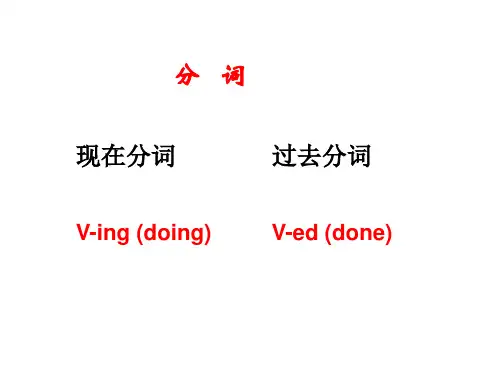

高中英语:非谓语动词考点全总结!含义+用法+例题讲解,三合一教会你!非谓语动词的含义非谓语动词首先是一种动词形式,其次是这种动词形式不能做谓语,综合这两点,我们将其叫做非谓语动词。
非谓语动词的形式非谓语动词包含四种形式,即不定式、动名词、现在分词和过去分词。
其中,每种形式按照发生时间和主被动又包括不同的子形式。
具体如下:1. 不定式①基本形式:to do(表示主动,并且一般表示将来)②被动式:to be done(表示被动,并且一般表示将来)③进行式:to be doing (表示主动和进行)④完成时:to have done(表示主动和完成)⑤完成被动式:to have been done(表示被动和完成)⑥完成进行式:to have been doing (表示主动和完成进行)The teacher told us to do morning exercises. 老师让我们做早操。
The car to be bought is for his sister.要买的这辆车是给他的姐姐的。
She pretended to be reading when the teacher came into the classroom.老师进来时,她假装正在读书。
The thief is said to have escaped.据说小偷已经逃跑了。
The thief is said to have been arrested.据说小偷已经被抓住了。
She is said to have been working in the factory over the last 20 years.据说在过去的20年里,她一直在这家工厂工作。
2. 动名词①基本形式:doing (表示主动)②被动式:being done(表示被动)③完成式:having done(表示主动和完成)④完成被动式:having been done(表示被动和完成)Travelling in space by ordinary people will be common in the future.在未来,普通人在太空旅行将会是普遍的事情。
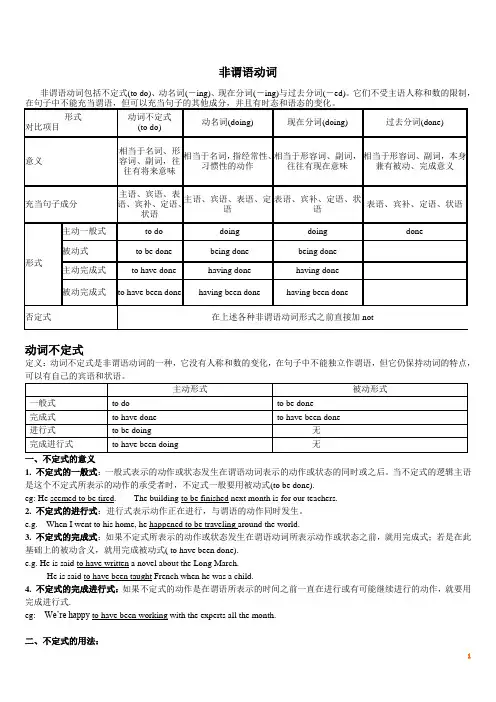
非谓语动词非谓语动词包括不定式(to do)、动名词(-ing)、现在分词(-ing)与过去分词(-ed)。
它们不受主语人称和数的限制,动词不定式定义:动词不定式是非谓语动词的一种,它没有人称和数的变化,在句子中不能独立作谓语,但它仍保持动词的特点,一、不定式的意义1. 不定式的一般式:一般式表示的动作或状态发生在谓语动词表示的动作或状态的同时或之后。
当不定式的逻辑主语是这个不定式所表示的动作的承受者时,不定式一般要用被动式(to be done).eg: He seemed to be tired. The building to be finished next month is for our teachers.2. 不定式的进行式:进行式表示动作正在进行,与谓语的动作同时发生。
e.g. When I went to his home, he happened to be traveling around the world.3. 不定式的完成式:如果不定式所表示的动作或状态发生在谓语动词所表示动作或状态之前,就用完成式;若是在此基础上的被动含义,就用完成被动式( to have been done).e.g. He is said to have written a novel about the Long March.He is said to have been taught French when he was a child.4. 不定式的完成进行式:如果不定式的动作是在谓语所表示的时间之前一直在进行或有可能继续进行的动作,就要用完成进行式.eg: We’re happy to have been working with the experts all the month.二、不定式的用法:1. 不定式做主语:不定式做主语一般表示具体的某次动作。
而动名词doing 表示习惯的,经常的动作。

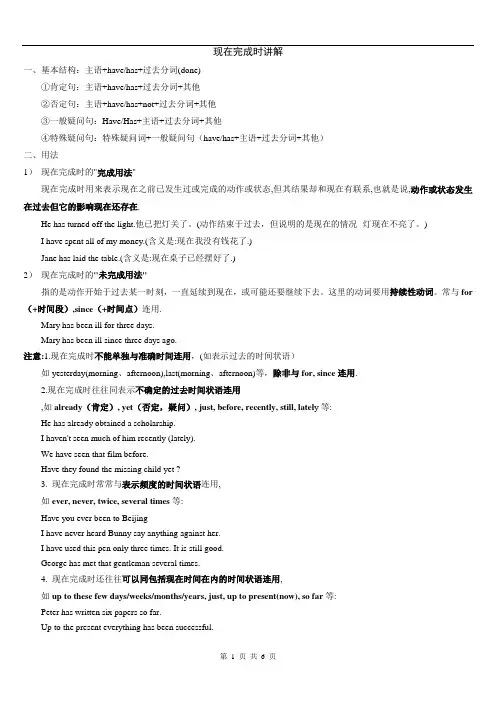
现在完成时讲解一、基本结构:主语+have/has+过去分词(done)①肯定句:主语+have/has+过去分词+其他②否定句:主语+have/has+not+过去分词+其他③一般疑问句:Have/Has+主语+过去分词+其他④特殊疑问句:特殊疑问词+一般疑问句(have/has+主语+过去分词+其他)二、用法1)现在完成时的"完成用法"现在完成时用来表示现在之前已发生过或完成的动作或状态,但其结果却和现在有联系,也就是说,动作或状态发生在过去但它的影响现在还存在.He has turned off the light.他已把灯关了。
(动作结束于过去,但说明的是现在的情况--灯现在不亮了。
)I have spent all of my money.(含义是:现在我没有钱花了.)Jane has laid the table.(含义是:现在桌子已经摆好了.)2)现在完成时的"未完成用法"指的是动作开始于过去某一时刻,一直延续到现在,或可能还要继续下去。
这里的动词要用持续性动词。
常与for (+时间段),since(+时间点)连用.Mary has been ill for three days.Mary has been ill since three days ago.注意:1.现在完成时不能单独与准确时间连用,(如表示过去的时间状语)如yesterday(morning、afternoon),last(morning、afternoon)等,除非与for, since连用.2.现在完成时往往同表示不确定的过去时间状语连用,如already(肯定), yet(否定,疑问), just, before, recently, still, latel y等:He has already obtained a scholarship.I haven't seen much of him recently (lately).We have seen that film before.Have they found the missing child yet ?3. 现在完成时常常与表示频度的时间状语连用,如ever, never, twice, several times等:Have you ever been to BeijingI have never heard Bunny say anything against her.I have used this pen only three times. It is still good.George has met that gentleman several times.4. 现在完成时还往往可以同包括现在时间在内的时间状语连用,如up to these few days/weeks/months/years, just, up to present(now), so far等:Peter has written six papers so far.Up to the present everything has been successful.5. 现在完成时还可以用来表示过去的一个时间到现在这段时间内重复发生的动作.We have had four texts this semester.6. have been to 和have gone to的区别have been to 强调“去过”,现已不在那里,如:He has been to the USA three times.他到美国去过三次。

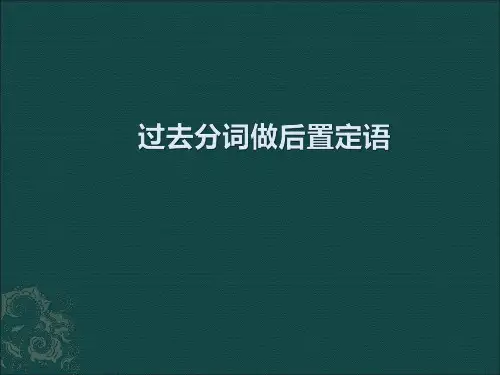

非谓语动词在高中英语中,非谓语动词包括动词不定式(to do)、动名词(-ing)、现在分词(-ing)与过去分词(-ed)三种形式,它们有不少共同特点:①在句子中不能充当谓语,不受主语人称和数的限制;②保留部分动词特性:可以后接宾语,可用副词修饰;③否定形式,都是在其前面加上not/never等否定词;④表示的动作,如果明显发生的谓语动词表示的动作之前(或者强调先后),要求用完成时态形式;⑤都不能作地点状语,只有动词不定式可以作目的状语;⑥没有主语,其表示动作的执行者叫作“逻辑性主语”(主动语态时),有时表示动作的承受者(被动语态时)非谓语动词可充当句子的很多成分,并且有时态和语态的变化如下:II动词ing形式的要点一. 动名词的时态和语态1.动名词的时态用法:1)一般式当动名词表示的动作正好与谓动同时发生或晚于谓动发生时,用一般式;e.g. ① He enjoys listening to music.② They are looking forward to visiting the science museum.2)完成式当动名词表示的动作明显早于谓动发生或强调动作的先后时,用完成式;e.g. ① She regretted having broken the law at that time.② They couldn`t remember having helped you with handwriting.2.动名词的被动语态用法:1)当动名词的逻辑性主语正好是其表示动作的承受者时,一般用被动;e.g. ① The president tried to avoid being questioned by the reporters.② The little boy remembered being given some sweets for his good deeds. ※为了避免太过累赘,常用一般被动式替代完成被动式;2)动名词的主动式表被动意义的用法:在want, need, require,(物作主语时) be worth, be busy等词后,常用动名词的主动形式表示被动意义;e.g. ① These desks want painting this afternoon.= These desks want to be painted this afternoon.② There are lot of places worth visiting in this city.3.逻辑性主语:动名词的逻辑性主语通常用(形容词性)物主代词或名词所有格来充当,但当其为无生命体、抽象名词或不定代词时,则常用普通格形式;e.g. ① Do you mind my smoking here?② I remember Lucy`s coming to Hangzhou for the first time.③ They are looking forward to the lesson coming to an end early.二.动名词的功能1. 动名词作主语:动名词作主语,强调一般普遍性或抽象性动作,而不定式强调个别或某次具体的动作!e.g. ① Reading aloud is important in learning a language.② Playing football is my favorite sport.※常有一些句型,动名词短语放在后面,仍然作真正的主语:1)句型一: It is + adj. /n. + doing其中it为形式主语,动名词短语才是真正的主语,适用的名词或形容词还有:no use/good, a waste of time, a pity, a good pleasure, time, useless, foolish, crazy, funny, interesting, worthwhile, nice, terrible, etc.e.g. ① It is no use crying over the spilt time.② It is great fun playing with the big big wolf.③It nice working with you.2)句型二:There is no + doing相当于句型:It is impossible to do sth……e.g. ① There is no joking on this matter.② There is no saying what may happen tomorrow.2. 动名词作宾语:1)主语+ 谓语+ doinge.g. ① When we got home, mum had finished cooking the supper yesterday.② Can you imagine floating on the sea for thirty days?※※要求只接动名词作宾语的动词还有:permit, admit, allow, forbid, ban, finish, complete, appreciate, avoid, bear, celebrate, delay, enjoy, escape, explain, include, keep, forgive, mention, practice, prevent, resist, suggest, postpone(推迟),consider(考虑), can`t help(禁不住), insist on, depend on, mean(打算), try(尝试) etc.2)句型结构:i). do+限定词(my, some, any, the等)+doing,表示“做……事”之意do some cleaning打扫卫生 do some shopping购物e.g. ① She likes doing some shopping on the weekend.ii). 用在worth, busy等形容词后面作宾语, 相当于固定搭配:e.g. ① This book is well worth reading.② The students are busy preparing for the final examination.iii). 主语 + have trouble/difficulty/a problem/a good time (in) doing 有困难/开心做…e.g. ① They had great difficulty finding the hotel.② He had a great time playing with the little dog.iv). 主语 + spend + time/money + doing 花时间或金钱做…e.g. ① They spent a lot of money collecting all the stamps.②The students always spend much time preparing for the final examination.v). 主语 + lose no time (in) + doing 立即做…e.g. ① They lost no time telling the teacher the good news.② The boy lost no time eating the nice delicious food as he was hungry too long.※在介词之后,通常用动名词作宾语,这是一个绝对概念;3)形式宾语用it作形式宾语,而真正的宾语则用动名词短语放在宾补之后;主语 + think/consider/find/feel like + it + useless/no use/no good + doinge.g. ① They found it useless explaining it to the big man.② The boy considered it no good arguing with his manager then.3 动名词作表语:动名词作表语, 表示对主语的解释说明, 可以和主语互换位置而整句意义不变;e.g. ① Her job is washing and cooking.② His favorite sport is playing basketball.4动名词作定语:动名词作定语, 表示被修饰词的功能用途, 使用范围等;e.g. ① This is a nice washing machine.② He has bought a new writing table.※动名词所修饰的名词(短语)不能充当其逻辑主语;。
非谓语动词-----过去分词done语法填空1.作定语单个过去分词作定语一般置于所修饰名词前,短语则放在所修饰词后。
Eg: the retired scientistPeople trapped in the lift若所修饰词由some/any/no+nothing/body/one及these,those等时放其后Eg: Is there anything unsolved。
过去分词短语可作非限制性定语,前后常用逗号隔开。
The book, written by Lu Xun, are popular with many Chinese people.Exercise 1:1).When first _____(introduce)to the market, these products enjoyed great success.2).Linda worked for the Manufacturing and Mining Company, _______(know)as 3M3).The disc, digitally_____(record)in the studio, sounded fantastic at the party that night.4). ______(Adapt)from Jane Austin’s classic, the BBC production Pride an d prejudice isuniversally acknowledged as the best so far.(2012 苏北四模)5). So far nobody has claimed the money_______(discover)in the library.(2010 湖南)2.作表语表示主语的心理感受或所处状态Eg: Don’t touch the glass because it is broken.She is quite pleased with the design of the dress.作表语与被动语态的区别Eg: The glass is broken.It was broken by my sister.过去分词和现在分词作表语的区别。
现在完成时讲解一、基本结构:主语+have/has+过去分词(done)①肯定句:主语+have/has+过去分词+其他②否定句:主语+have/has+not+过去分词+其他③一般疑问句:Have/Has+主语+过去分词+其他④特殊疑问句:特殊疑问词+一般疑问句(have/has+主语+过去分词+其他)二、用法1)现在完成时的"完成用法"现在完成时用来表示现在之前已发生过或完成的动作或状态,但其结果却和现在有联系,也就是说,动作或状态发生在过去但它的影响现在还存在.He has turned off the light.他已把灯关了。
(动作结束于过去,但说明的是现在的情况--灯现在不亮了。
)I have spent all of my money.(含义是:现在我没有钱花了.)Jane has laid the table.(含义是:现在桌子已经摆好了.)2)现在完成时的"未完成用法"指的是动作开始于过去某一时刻,一直延续到现在,或可能还要继续下去。
这里的动词要用持续性动词。
常与for (+时间段),since(+时间点)连用.Mary has been ill for three days.Mary has been ill since three days ago.注意:1.现在完成时不能单独与准确时间连用,(如表示过去的时间状语)如yesterday(morning、afternoon),last(morning、afternoon)等,除非与for, since连用.2.现在完成时往往同表示不确定的过去时间状语连用,如already(肯定), yet(否定,疑问), just, before, recently, still, latel y等:He has already obtained a scholarship.I haven't seen much of him recently (lately).We have seen that film before.Have they found the missing child yet ?3. 现在完成时常常与表示频度的时间状语连用,如ever, never, twice, several times等:Have you ever been to BeijingI have never heard Bunny say anything against her.I have used this pen only three times. It is still good.George has met that gentleman several times.4. 现在完成时还往往可以同包括现在时间在内的时间状语连用,如up to these few days/weeks/months/years, just, up to present(now), so far等:Peter has written six papers so far.Up to the present everything has been successful.5. 现在完成时还可以用来表示过去的一个时间到现在这段时间内重复发生的动作.We have had four texts this semester.6. have been to 和have gone to的区别have been to 强调“去过”,现已不在那里,如:He has been to the USA three times.他到美国去过三次。
"Done" 是英语动词"do" 的过去分词形式,通常用作形容词或动词的完成时态。
当用作主语时,它通常表示已经完成的动作或事情。
以下是一些使用"done" 作为主语的例句:
1. "Done" 可以作为抽象名词,表示完成的状态或动作:
- Done is better than perfect. (完成比完美更重要。
)
2. "Done" 可以与"the" 连用,表示特定的已完成的事情:
- The done deed cannot be undone. (已做的事情无法撤销。
)
3. "Done" 可以在句子中作为代词使用,指代前面提到的已完成的动作:
- I have finished my work, and it's done. (我已经完成了我的工作,已经做好了。
)
4. "Done" 可以在比较结构中作为名词使用:
- There's more to do than what's been done. (还有更多的事情要做,而不仅仅是已经完成的。
)。
高中英语语法:非谓语动词总结-大全非谓语动词的含义非谓语动词首先是一种动词形式,其次是这种动词形式不能做谓语,综合这两点,我们将其叫做非谓语动词。
非谓语动词的形式非谓语动词包含四种形式,即不定式、动名词、现在分词和过去分词。
其中,每种形式按照发生时间和主被动又包括不同的子形式。
具体如下:1. 不定式①基本形式:to do(表示主动,并且一般表示将来)②被动式:to be done(表示被动,并且一般表示将来)③进行式:to be doing (表示主动和进行)④完成时:to have done(表示主动和完成)⑤完成被动式:to have been done(表示被动和完成)⑥完成进行式:to have been doing (表示主动和完成进行)The teacher told us to do morning exercises. 老师让我们做早操。
The car to be bought is for his sister. 要买的这辆车是给他的姐姐的。
She pretended to be reading when the teacher came into the classroom. 老师进来时,她假装正在读书。
The thief is said to have escaped. 据说小偷已经逃跑了。
The thief is said to have been arrested. 据说小偷已经被抓住了。
She is said to have been working in the factory over the last 20 years. 据说在过去的20年里,她一直在这家工厂工作。
2. 动名词①基本形式:doing (表示主动)②被动式:being done(表示被动)③完成式:having done(表示主动和完成)④完成被动式:having been done(表示被动和完成)Travelling in space by ordinary people will be common in the future. 在未来,普通人在太空旅行将会是普遍的事情。